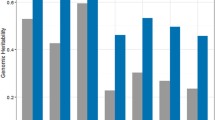Abstract
The shell thickness gene Sh is one of the most important genes in oil palm. It controls the fruit type which in turn is associated with palm oil yield. Based on previous information about Sh alleles, we have developed a molecular marker system which is composed of three primer pairs and the application of two restriction enzymes which allows to discriminate between one dura and two pisifera alleles that are currently known. The different components of this marker system have been validated on 207 dura genotypes and 50 pisifera genotypes of different origins, as well as in 242 tenera genotypes derived from crosses of individual dura and pisifera palms. All evaluated genotypes showed the amplification products or restriction fragments, indicating a general applicability of the proposed system. The results of the application of this molecular marker system were compiled for all potentially existing fruit type genotypes, and can be used conveniently for selecting the desired genotypes or for identifying specific genotypes in mixtures. Methodological details were indicated for applying the marker system, as well as limitations with respect to potentially existing genetic variability. Useful applications of the system for breeding and seed certification are discussed.

Similar content being viewed by others
References
Ajambang W, Sudarsono Asmono D, Touran N (2012) Microsatellite markers reveal Cameroon’s wild oil palm population as a possible solution to broaden the genetic base in the Indonesia–Malaysia oil palm breeding programs. Afr J Biotechnol 11(69):13244–13249. doi:10.587/AJB11.3897
Arias D, Montoya C, Romero H (2012) Molecular characterization of oil palm Elaeis guineensis Jacq. materials from Cameroon. Plant Genet Resour. doi:10.1017/S1479262112000482
Arias D, González M, Prada F, Restrepo E, Romero H (2013) Morpho-agronomic and molecular characterisation of oil palm Elaeis guineensis Jacq. material from Angola. Tree Genet Genomes 9(5):1283–1294. doi:10.1007/s11295-013-0637-5
Arias D, Ochoa I, Castro F, Romero H (2014) Molecular characterization of oil palm Elaeis guineensis Jacq. of different origins for their utilization in breeding programs. Plant Genet Resour. doi:10.1017/S1479262114000148
Bakoumé C, Wickneswari R, Siju S, Rajanaidu N, Kushairi A, Billotte N (2014) Genetic diversity of the world’s largest oil palm (Elaeis guineensis Jacq.) field genebank accessions using microsatellite markers. Genet Resour Crop Evol 62:349–360. doi:10.1007/s10722-014-0156-8
Beirnaert A, Vanderweyen R (1941) Contribution a l’étude génétique et biométrique des variétés d’Elaeis guineensis Jacq. Publ. Inst. Nat. Etude agron. Congo Belge. Ser Sci 27:1–101
Billotte N, Marseillac N, Risterucci AM, Adon B, Brottier P, Baurens FC, Singh R et al (2005) Microsatellite-based high density linkage map in oil palm (Elaeis guineensis Jacq.) TAG. Theor Appl Genet 110(4):754–765. doi:10.1007/s00122-004-1901-8
Cochard B, Adon B, Rekima S, Billotte N, de Chenon RD, Koutou A et al (2009) Geographic and genetic structure of African oil palm diversity suggests new approaches to breeding. Tree Genet Genomes 5(3):493–504. doi:10.1007/s11295-009-0203-3
Corley RHV, Tinker PHB (2003) The oil palm. Blackwell Publishing, Oxford
Dreni L, Kater MM (2014) MADS reloaded: evolution of the AGAMOUS subfamily genes. New Phytol 201(3):717–732. doi:10.1111/nph.12555
Donini P, Cooke RJ, Reeves JC (2000) Molecular markers in variety and seed testing. Dev Plant Genet Breed 5:27–34. doi:10.1016/S0168-7972(00)80005-5
Giovannoni JJ (2004) Genetic regulation of fruit development and ripening. Plant Cell 16:170–180. doi:10.1105/tpc.019158
Kushairi A, Rajanaidu N (2000) Breeding populations, seed production and nursery management. In: Basiron Y, Jalani BS and Chan KW (Eds) Advances in oil palm research. MPOB 1:39–96
Mayes S, Jack PL, Marshall DF, Corley RHV (1997) Construction of a RFLP genetic linkage map for oil palm (Elaeis guineensis Jacq.). Genome 40(1):116–122. doi:10.1139/g97-016
Moretzsohn MC, Nunes CDM, Ferreira ME, Grattapaglia D (2000) RAPD linkage mapping of the shell thickness locus in oil palm (Elaeis guineensis Jacq.). Theor Appl Genet. doi:10.1007/s00421-008-0955-8
Rozen S, Skaletsky HJ (2000) Primer3 on the WWW for general users and for biologist programmers. In: Krawetz S, Misener S (eds) Bioinformatics methods and protocols: methods in molecular biology. Humana Press, Totowa, pp 365–386
Singh R, Low ET, Ooi LC, Ong-Abdullah M, Ting NC, Nagappan J, Nookiah R, Amiruddin MD, Rosli R, Manaf MA et al (2013a) The oil palm SHELL gene controls oil yield and encodes a homologue of SEEDSTICK. Nature. doi:10.1038/nature12356
Singh R, Ong-Abdullah M, Low ETL, Manaf MAA, Rosli R, Nookiah R, Sambanthamurthi R et al (2013b) Oil palm genome sequence reveals divergence of interfertile species in old and new worlds. Nature. doi:10.1038/nature12309
Tranbarger TJ, Kluabmongkol W, Sangsrakru D, Morcillo F, Tregear JW, Tragoonrung S, Billotte N (2012) SSR markers in transcripts of genes linked to post-transcriptional and transcriptional regulatory functions during vegetative and reproductive development of Elaeis guineensis. BMC Plant Biol 12(1):1. doi:10.1186/1471-2229-12-1
United States Department of Agriculture (2014) Oilseeds: world markets and trade. http://www.fas.usda.gov/data/oilseeds-world-markets-and-trade. Accessed 2 Dec 2014
Zhao Q, Weber AL, McMullen MD, Guill K, Doebley J (2011) MADS-box genes of maize: frequent targets of selection during domestication. Genet Res 93(1):65–75. doi:10.1017/S0016672310000509
Author information
Authors and Affiliations
Corresponding author
Rights and permissions
About this article
Cite this article
Ritter, E., de Armentia, E.L., Erika, P. et al. Development of a molecular marker system to distinguish shell thickness in oil palm genotypes. Euphytica 207, 367–376 (2016). https://doi.org/10.1007/s10681-015-1553-6
Received:
Accepted:
Published:
Issue Date:
DOI: https://doi.org/10.1007/s10681-015-1553-6




